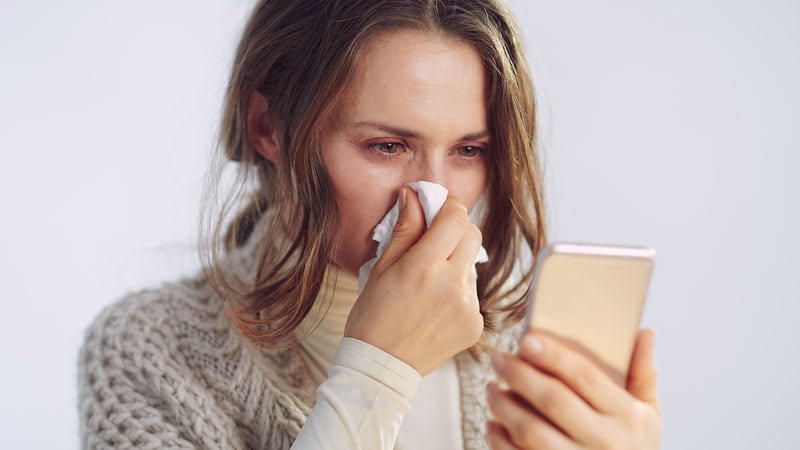Published evidence from a handful of mobile health apps show their potential to assist in the diagnosis of rhinitis and rhinosinusitis as well as to evaluate management and treatment adherence for these conditions, a new report suggests.
Despite their promise in clinical management, few have been validated in the scientific literature, and even fewer include considerations for multimorbidity.
The research findings were published online in Clinical and Translational Allergy.
Advantages to Mobile App Technology
Lead study author Bernardo Sousa‐Pinto, MD, of the University of Porto in Portugal, explained to Medscape Medical News that there are several reasons justifying the use of digital health apps for rhinitis and rhinosinusitis.
“Rhinitis and rhinosinusitis are chronic diseases whose control may fluctuate considerably between outpatient visits,” Sousa‐Pinto said.
He explained that digital health apps typically have patients register their daily symptoms, which in turn may allow clinicians to better understand how patients’ symptoms vary over time. “This is something that can be very hard to achieve by other means,” he said.
Sousa‐Pinto commented that by better understanding how symptoms fluctuate between visits, clinicians can make more informed treatment adjustments “and even help in the identification of the allergens to which the patient is sensitized.”
James A. Tarbox, MD, an associate professor of allergy and immunology at Texas Tech University Health Sciences Center in Lubbock, Texas, told Medscape Medical News that in addition to supporting the management of allergic diseases, the data garnered from mobile health apps may also help in scientific investigations and could be used in guideline recommendations.
“You also could potentially optimize allergy immunotherapy based upon tracking patients’ symptoms during pollen seasons,” added Tarbox, who wasn’t involved in the research.
Furthermore, Sousa‐Pinto noted that digital health tools allow patients to provide data about how they perceive the impacts of rhinitis and rhinosinusitis on different domains of life, including work productivity, quality of life, and ability to perform leisure activities.
“Digital health tools may also help empower patients in understanding and better taking control of their disease,” Sousa‐Pinto added. “By registering their symptoms and medication use, patients are able to better witness their daily symptoms and may be more conscious of the need of achieving a better rhinitis control.”
Seven Apps With Published Studies
In their study, Sousa‐Pinto and colleagues applied both automatic and manual search methods to identify relevant rhinitis and rhinosinusitis apps in the Google Play and Apple App stores and to examine the apps’ implications for diagnosis, management, and treatment adherence.
Only apps that allowed patients to register their daily symptoms and medication use were considered.
Among the 1500 apps for allergic rhinitis and the several hundred for chronic rhinosinusitis, the researchers identified only seven internationally relevant apps with corresponding scientific publications on their methodologic or clinical validation.
Sousa‐Pinto said that the small number on their use sparked “some concerns on the quality of the many available apps.”
The researchers identified six apps for rhinitis (AirRater, AllergyMonitor, AllerSearch, Husteblume, MASK‐air, and Pollen App) and one single app for rhinosinusitis (Galenus Health) with some level of scientific literature on their use. Only the MASK-air included a focus on asthma multimorbidity.
The published results of the seven evaluated rhinitis and rhinosinusitis apps demonstrate potential for identifying allergy phenotypes, identifying the pollen season, and discerning the role of air pollution in rhinitis symptoms, the authors wrote.
In addition, some of the apps also provided combined symptom-medication scores capable of assessing rhinitis control; other apps demonstrated potential for assessing diagnostic algorithms and treatment adherence.
Adding to the discussion on the potential clinical implications of these apps, Sousa‐Pinto said that these tools can be important in achieving better rhinitis and rhinosinusitis control in the contexts where patients have lower access to healthcare.
“In fact, while these apps do not replace outpatient visits, they can help patients better manage their disease in contexts where the frequency of physician visits are suboptimal,” he said.
Improving App Uptake
According to Tarbox, there is a need to improve patient uptake of digital tools, particularly in patients with multiple allergic diseases.
“We also need to make sure the apps that we are recommending have been verified and can provide helpful information,” he said. “This information can not only be used for our patients but can also help with proposed medical and environmental guidelines in the future.”
Given the reported benefits of mobile health apps in allergic diseases, clinicians should be aware of the available apps to ensure “the most adequate ones” are suggested to patients, according to Sousa‐Pinto. “The apps whose questions and questionnaires have been validated and which respect data privacy may be the most adequate ones to suggest,” he explained.
Apps that allow users to share their data with physicians easily during a medical consultation may also provide an increased motivation among patients to use these tools, Sousa‐Pinto added. “We strongly think that apps will improve shared decision-making for digitally enabled, patient-centered care,” he commented.
The study was independently supported. Sousa ‐ Pinto and Tarbox report no relevant financial relationships.
Clin Transl Allergy. November 18, 2022. Full text
Brandon May is a freelance medical journalist who has written more than 2100 articles for medical publications in the United States and the UK. Twitter: @brandonmilesmay
For more news, follow Medscape on Facebook, Twitter, Instagram, and YouTube
Source: Read Full Article






